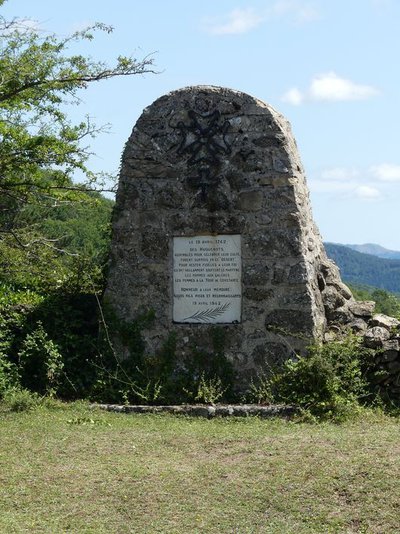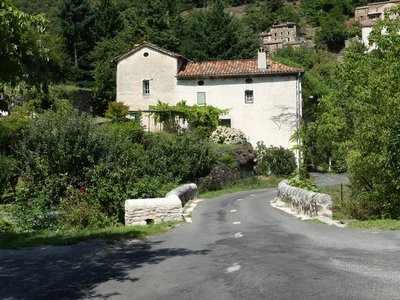
Col de Mouzoules
3 points of interest

La fauvette à tête noire - Bruno Descaves  Fauna
FaunaEurasian blackcap
Oak forest predominates on this slope but as you get closer to the pass, the trees become rarer. With a bit of luck, you may see a Eurasian blackcap. Its feathers are inconspicuous but the male can easily be identified by its shiny black cap, which stops abruptly just above the eyes. The blackcap particularly likes shrubs and dense thickets, where it builds its nest out of grasses. It sings vigorously in spring, but stops in mid-July.
Stèle au col de Mouzoules - N. Thomas  History
HistoryMemorial stone for the Camisards and the Gathering in the Wilderness
The stone commemorates the arrest of a gathering of Camisards on 17 April 1742. After Luther’s Reformation in 1521, the Cévenols had converted en masse. By 1560, there were already numerous Protestant communities in the region. The 1598 Edict of Nantes accorded Protestants the freedom of conscience and the freedom to worship. And yet, from 1660 onwards, harassment began with the prohibition of certain positions for Huguenots. The King’s soldiers (the Dragoons) were billeted in locals’ houses and given the right to do anything short of killing them. Brutality, bullying, pillaging of food, destruction of possessions and forced baptisms incited locals to convert to Catholicism. This regime of terror was so effective that just the threat of such a dragonnade sufficed to convert entire villages. (...) A gathering in the Wilderness [secret Protestant service in an isolated outdoors location] was held at Mouzoules. It was denounced by a traitor who, after the tragedy, was forced by the Huguenots to dig his own tomb at the bottom of the Mouzoules meadow. Eleven people were arrested. The men were sent to the galleys, the women locked up in the Tour de Constance tower in Aigues-Mortes. Not one of the women recanted; most died there.

Mars - N. Thomas  History
HistoryThe village of Mars
The village of Mars takes its name from the Latin name Marcius or, according to some, from the God of iron because there used to be iron mining near the village. The forged-iron guardrail at the Mairie (town hall) shows three wild boars and symbolises the interest of a part of the population in hunting.
On the return leg, before entering the village, you will see granite rocks of an astonishing size. On 14 September 1843, torrents of rain fell on Quier mountain, which Mars backs onto.
The rocks were allegedly transported here by the water that day.
Description
Signposts will guide you all along this route. In the description below, the signposted place names and/or directions are given in bold italics between quotation marks:
Starting at “MARS ", walk towards "COL DE MOUZOULES" via:
- "Le Truel" and
- "Cougnéral".
At the signpost "Cougnéral", walk to the Col de Mouzoules pass, then retrace your steps.
Back at the signpost "Cougnéral", head towards "BRÉAU" via: - "La Bernadelle - Ouest".
- At “Bréau”, walk towards "MARS" via:
- "Fontaine de La Surle" and
- "La Bernadelle - Est".
This walk is taken from the guidebook Les Vallées Cévenoles - En Pays Viganais, published by the Communauté de communes Pays Viganais-Cévennes as part of the collection Espaces Naturels Gardois and the label Gard Pleine Nature.
- Departure : Mars: Mairie (town hall)
- Arrival : Mars: Mairie (town hall)
- Towns crossed : Bréau-Mars
Forecast
Altimetric profile
Recommandations
Make sure your equipment is appropriate for the day’s weather conditions. Take enough water, wear sturdy shoes and put on a hat. Please close all gates and barriers behind you.
Information desks
Tourism office Cévennes and Navacelles, Le Vigan
Maison de pays, place du Marché, BP 21, 30120 Le Vigan
This office is part of the National Park's associated tourist-information network, whose mission is to provide information on, and raise awareness of, the sites and events as well as the rules that must be observed in the National Park's central zone.
Open year-round
Transport
Access and parking
From Le Vigan toward Cavaillac on the D999, then towards Aulas on the D190, then to Mars on the D272.
Parking :
Calculateur d'itinéraire Lio
Utilisez le calculateur liO pour organiser votre trajet en région Occitanie.
Autres régions
Calculez votre itinéraire en Auvergne Rhône Alpes sur Oùra
Biodiversité autour de l'itinéraire
Source


Report a problem or an error
If you have found an error on this page or if you have noticed any problems during your hike, please report them to us here:

